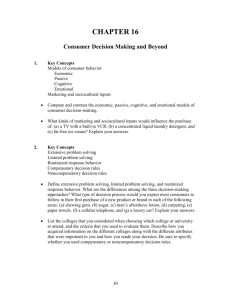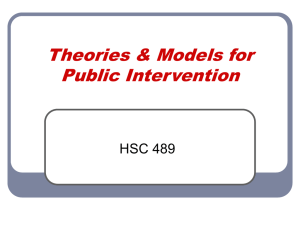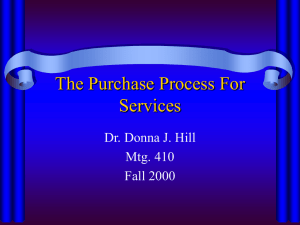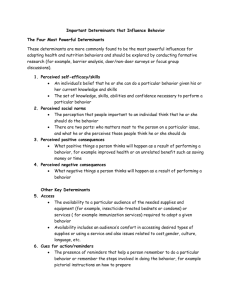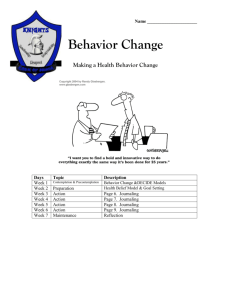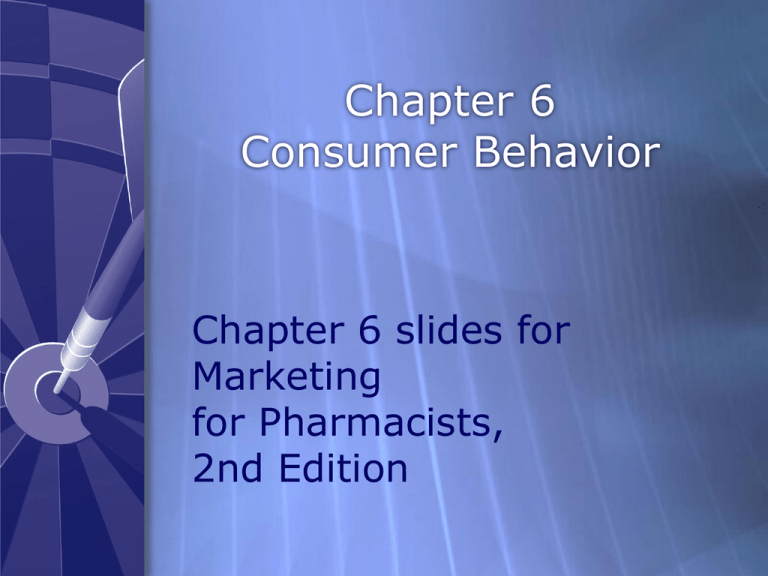
Chapter 6
Consumer Behavior
Chapter 6 slides for
Marketing
for Pharmacists,
2nd Edition
Learning Objectives
Describe the steps associated with
consumer decision-making.
Delineate how each step influences the
choices consumers make.
Discuss how risk, involvement, control,
and expectations affect consumers’
decision-making.
Give a general description of the following
models of health behavior: health belief
model, theory of reasoned action, theory of
planned behavior, transtheoretical model.
Consumer (Patient) Behavior
Understanding consumer behavior
is necessary in pricing,
merchandising, advertising,
personal selling, designing
services, and so on.
It helps in knowing who, what,
when, where, and how to market.
e.g., diabetes management clinic
The aim of marketing is to know
and understand the customer so
well the product or service fits
him and sells itself.
Peter F. Drucker
Frameworks for Understanding
Consumer Behavior
Economic man
Social influences
Personal influences
Consumer Purchase Situations
Types of
Consumer
Decisions
New
Extended
Problem Solving
Repeat
Limited
Problem Solving
First Choice
Impulse Decisions
Of Important
Product or Service
Extended
Problem Solving
Variety Seeking,
Dissatisfaction with
Current Choice
Limited
Problem Solving
Habitual Choices,
Brand Loyalty
Problem Solving
Extended problem solving
New, high-risk, complex
Limited problem solving
Routine, low-risk
Determines attention and receptivity
to information
Consumer
Decision
Process
Need Recognition
Information Search
Alternative Evaluation
Choice
Evaluation
Consumer
Decision
Process
Need Recognition
Prepurchase
Stage
Information Search
Alternative Evaluation
Consumption
Stage
Choice
Postpurchase
Evaluation Stage
Evaluation
Consumer Decision Process
Need recognition
(arousal, interest, desire)
Commercial
Social
Physical
Information search
Internal
External
Consumer Decision Process
Alternative evaluation
Cognitive versus emotional
Salient (important) versus determinant
criteria
Consumption
Choice of vendor, channel of distribution,
product
Decision rules: cutoffs, overall utility
Postpurchase
Satisfaction versus cognitive dissonance
How might
pharmacists
influence the
decision process
for seeking
treatment for
diabetes?
Need Recognition
Prepurchase
Stage
Information Search
Alternative Evaluation
Consumption
Stage
Postpurchase
Evaluation Stage
Choice
Evaluation
Variables Affecting
Consumer Decisions
Risk
(e.g., diabetes)
Financial
Performance
Physical
Social
Psychological
Dimensions:
severity and
likelihood
Involvement
(i.e., perceived importance)
Affects information search and
processing and ability to be
persuaded
Necessary for thoughtful behavior
(extended problem solving)
Influenced by
Personal relevance
Object considered
Situation
Customizing services to patient
involvement (e.g., diabetes)
Assess patient involvement
For highly involved, greater information can
be provided.
For less highly involved, provide simple,
short, repetitive messages.
Enhance involvement through education
and reducing distractions.
Tell me and I'll forget. Show me and I'll remember.
Involve me and I'll understand.
- Confucius (famous Chinese marketer)
Perception of control
Lack of perceived control leads to
stress and frustration.
Enhance feelings of control
Provide information about what is
going on.
Give control through self-service
and choice.
Make service experiences as consistent
and predictable as possible.
Health Behavior Models
commonly
used in
pharmacy
practice
For counseling
and intervention
strategies
Health belief model
•
Patient health behaviors are
determined by
•
•
The degree to which a patient
perceives a particular health threat
Whether the patient believes the
particular behavior will reduce the
threat.
Kehoe WA, Katz RC. Health Behaviors and Pharmacotherapy. Ann Pharmacotherapy 1998;32:1076-1085.
Ried LD, Christensen DB. A Psychosocial Perspective in the Explanation of Patients’ Drug-Taking Behavior.
Soc Sci Med 1988; 27(3): 277-285.
Health belief model
Actions are directly related to
A patient’s feelings of susceptibility to a disease
Concern about worsening of the disease
A belief that the disease will get better with
treatment
The patient’s assessment of risks versus benefits
Stimulus that motivates the patient
Internal: signs and symptoms of disease
External: personal pressure from family or medical
professionals
Nagy VT, Wolfe GR. Cognitive Predictors of Compliance in Chronic Disease Patients. Med Care 1984; 22:912-921.
Kehoe WA, KatzRC. Health Behaviors and Pharmacotherapy. Ann Pharmaco 1998;32:1076-1085.
Health belief model
Age, Sex, Ethnicity
Personality, Knowledge
Socioeconomics
Perceived
Susceptibility
or Seriousness
Perceived
Threat
Cues to Action
•Education
•Symptoms
•Media
Likelihood of
Taking Action
Theory of reasoned action
Beliefs,
Importance
Attitude
Intentions
To Act
Expectations,
Importance
Subjective
Norm
Actual
Behavior
Transtheoretical model
States that people progress through
five stages when changing a behavior.
These stages identify one’s
motivational and behavioral readiness
for change.
The success of behavior-changing
strategies depends on what stage a
person is in.
Stages of change
Stage 1: Precontemplation
No intention of changing in foreseeable
future
Efforts to get person to make immediate
change will likely meet resistance
Stage 2: Contemplation
Intention to change in foreseeable future
but unwilling to act yet
Stages of change
Stage 3: Preparation
Have begun to take small steps toward
change in very near future
Stage 4: Action
Have successfully made change in past
6 months
Stage 5: Maintenance
Change more than 6 months ago
Decisional balance
Pros
(Benefits of change)
Cons
(Negatives of change)
Pre-contemplators and Contemplators
Decisional balance
Cons
(Negatives of change)
Pros
(Benefits of change)
, Action, Maintenance Preparation
Important points
On average, 40-60% of people in
the process of change are in stage
1 or 2.
Many change efforts attempt to
change behavior of people who are
not ready to take action (stage 1
or 2). The result is resistance and
relapse.
Making a change
In stages 1 and 2, focus is on negatives
of change. Increasing the likelihood of
change requires
Increasing the perceived benefits of change
Increasing people’s confidence that they are
able to change.
Stages 3 to 5 consist primarily of
managing temptations to slide back into
previous undesirable behavior.
Summary
Understanding patient behavior is
essential to influencing them.
Models of consumer behavior can help
pharmacists increase medication
adherence, change smoking behavior,
communicate health messages, design
services, and influence physician
prescribing.
Questions?

